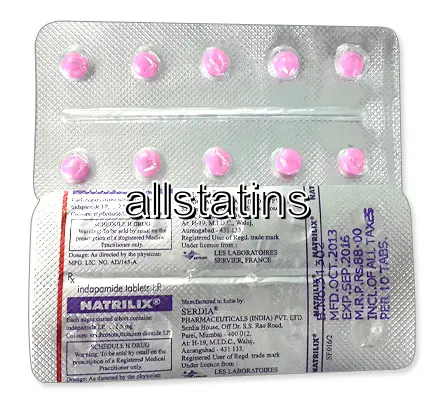| Package | Dosage | Price | Price per Dose | |
|---|---|---|---|---|
| Dosage: 1,5mg | ||||
| 360 pill | 1,5mg | $717.58 | $1.99 | |
| 180 pill | 1,5mg | $382.10 | $2.12 | |
| 120 pill | 1,5mg | $265.49 | $2.22 | |
| 90 pill | 1,5mg | $206.29 | $2.30 | |
| 60 pill | 1,5mg | $147.09 | $2.46 | |
| 30 pill | 1,5mg | $77.12 | $2.55 | |
| Dosage: 2,5mg | ||||
| 180 pill | 2,5mg | $432.34 | $2.40 | |
| 120 pill | 2,5mg | $310.34 | $2.58 | |
| 90 pill | 2,5mg | $249.35 | $2.76 | |
| 60 pill | 2,5mg | $177.59 | $2.94 | |
| 30 pill | 2,5mg | $93.27 | $3.12 | |

Lozol Description
Introduction to Lozol
Lozol, known generically as indapamide, is a medication commonly used to manage high blood pressure and fluid retention. It belongs to a class of drugs called thiazide-like diuretics, which help eliminate excess salt and water from the body. In the United States, Lozol is prescribed by healthcare providers to reduce the risk of strokes, heart attacks, and kidney problems associated with hypertension. Patients often appreciate its effectiveness and its relatively mild side effect profile compared to other diuretics.
How Lozol Works
Lozol works by relaxing blood vessels, which helps lower blood pressure, making it easier for the heart to pump blood throughout the body. It also promotes the removal of excess fluid through increased urination. This dual action not only helps control blood pressure but also relieves symptoms of fluid retention, such as swelling in legs, ankles, or feet. Many healthcare providers in the U.S. favor Lozol because it tends to cause fewer disturbances in metabolic parameters than some other diuretics.
Usage and Dosage
In the United States, Lozol is typically taken once daily, in the morning, to prevent nighttime urination and to maximize its effectiveness. The dosage depends on the individual’s condition and response to treatment. Most patients start with a low dose, which can be gradually increased under the supervision of a healthcare professional. It is important to follow the prescribed instructions carefully and not to adjust the dose without medical advice, as improper use can lead to dehydration or electrolyte imbalances.
Review of Effectiveness
Many users of Lozol report noticeable improvements in their blood pressure levels within a few weeks of starting treatment. It is often praised for its gentle yet effective action, especially among patients who prefer a medication with fewer side effects. In clinical practice across the U.S., Lozol has demonstrated a consistent ability to lower systolic and diastolic blood pressure, helping patients reduce their reliance on multiple medications. Patients also find that its diuretic effect helps reduce swelling and improve overall comfort.
Possible Side Effects and Precautions
While Lozol is generally well tolerated, some users in the United States do experience side effects. Common issues include increased urination, dizziness, or mild electrolyte disturbances. Less frequently, some patients might encounter symptoms such as low potassium or magnesium levels, which require regular monitoring. It is crucial for individuals taking Lozol to stay well-hydrated and have their blood pressure and electrolytes checked periodically by their doctor. Patients with certain medical conditions, like gout or kidney problems, should discuss these with their healthcare provider before starting Lozol.
Availability and Considerations
In the U.S., Lozol is available through licensed pharmacies and requires a prescription from a healthcare professional. Some patients prefer online pharmacies for convenience, but it is essential to choose reputable sources to ensure medication safety and authenticity. Always consult with a healthcare provider to determine if Lozol is suitable for your specific health needs and to receive proper dosage instructions. Regular follow-up is vital to monitor its effectiveness and to manage any potential side effects properly.
User Feedback
Overall, many users in the United States who take Lozol report satisfaction with its performance. They appreciate its once-daily dosing and the noticeable reduction in blood pressure readings. Patients also highlight its relative safety when used as directed. However, some mention mild side effects such as increased urination or lightheadedness, which usually subside over time or with dosage adjustments. As always, individual responses vary, so personalized medical advice remains crucial.